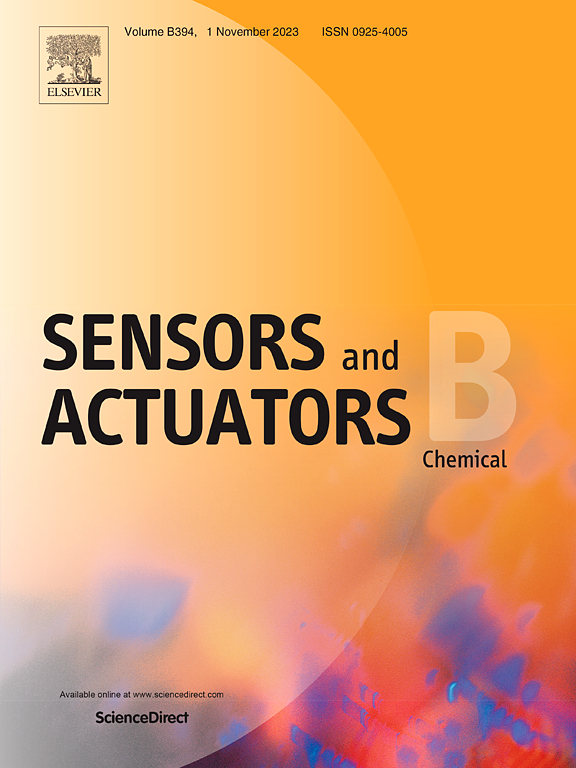Preparation and application of EpCAM electrochemiluminescent aptamer sensor based on porous UiO-66(Ce) loading CdTe/CdS quantum dots
IF 8
1区 化学
Q1 CHEMISTRY, ANALYTICAL
引用次数: 0
Abstract
Epithelial cell adhesion molecule (EpCAM) is a transmembrane glycoprotein and its detection is important for diagnosis and therapeutic prognostic assessment of many cancers. Herein, a highly sensitive electrochemiluminescence (ECL) sensor was developed for its detection. In the ECL sensor, dimercaptosuccinic acid-capped core/shell structured CdTe/CdS quantum dot (QD) was loaded on metal-organic framework material UiO-66(Ce) as electrochemical luminophore; Ti3C2/Ag composite was introduced for immobilizing EpCAM aptamer. Due to the well immobilization of QD and catalysis of UiO-66(Ce), the obtained luminophore CdTe/CdS QDs@UiO-66(Ce) displayed a strong and stable ECL signal. Furthermore, the Ti3C2/Ag could act as a co-reactant accelerator to boost the ECL signal. Thus, the resulted sensor had quite strong initial ECL signal for signal-off detection. Further experiment showed that it exhibited good linear response to EpCAM over the concentration range of 1 pg mL−1− 10 ng mL−1 in pH 7.4 Tris buffer, with a detection limit low to 0.66 pg mL−1. Additionally, the ECL sensor also presented high selectivity and satisfying reproducibility; its practicability was demonstrated by the successful determination of EpCAM in serum samples.

基于多孔 UiO-66(Ce)负载 CdTe/CdS 量子点的 EpCAM 电化学发光适配体传感器的制备与应用
上皮细胞粘附分子(EpCAM)是一种跨膜糖蛋白,其检测对于许多癌症的诊断和治疗预后评估非常重要。在此,我们开发了一种高灵敏度的电化学发光(ECL)传感器来检测它。在 ECL 传感器中,将二巯基丁二酸封端的核/壳结构 CdTe/CdS 量子点(QD)负载在金属有机框架材料 UiO-66(Ce) 上作为电化学发光体;引入 Ti3C2/Ag 复合材料固定 EpCAM 氨基甲酸乙酯。由于 QD 的良好固定性和 UiO-66(Ce) 的催化作用,得到的发光体 CdTe/CdS QDs@UiO-66(Ce) 显示出强烈而稳定的 ECL 信号。此外,Ti3C2/Ag 可作为共反应加速剂,增强 ECL 信号。因此,制备出的传感器具有相当强的初始 ECL 信号,可用于信号关断检测。进一步的实验表明,在 pH 值为 7.4 的 Tris 缓冲液中,EpCAM 在 1 pg mL-1-10 ng mL-1 的浓度范围内表现出良好的线性响应,检测限低至 0.66 pg mL-1。此外,ECL 传感器还具有高选择性和令人满意的重现性;成功测定血清样品中的 EpCAM 证明了它的实用性。
本文章由计算机程序翻译,如有差异,请以英文原文为准。
求助全文
约1分钟内获得全文
求助全文
来源期刊

Sensors and Actuators B: Chemical
工程技术-电化学
CiteScore
14.60
自引率
11.90%
发文量
1776
审稿时长
3.2 months
期刊介绍:
Sensors & Actuators, B: Chemical is an international journal focused on the research and development of chemical transducers. It covers chemical sensors and biosensors, chemical actuators, and analytical microsystems. The journal is interdisciplinary, aiming to publish original works showcasing substantial advancements beyond the current state of the art in these fields, with practical applicability to solving meaningful analytical problems. Review articles are accepted by invitation from an Editor of the journal.
 求助内容:
求助内容: 应助结果提醒方式:
应助结果提醒方式:


